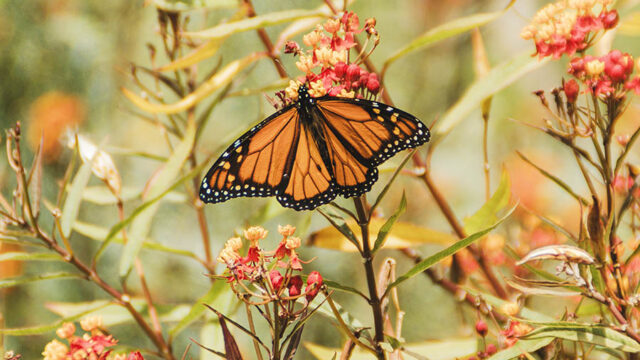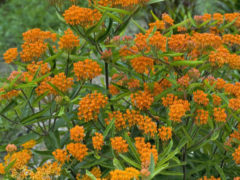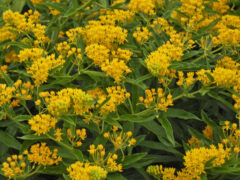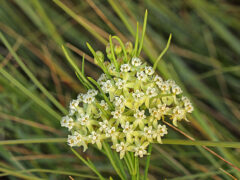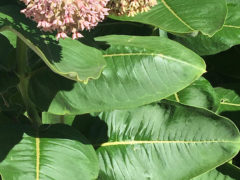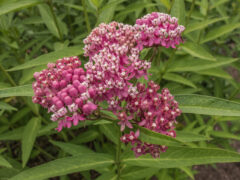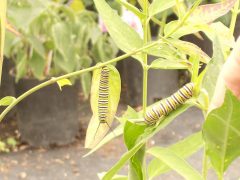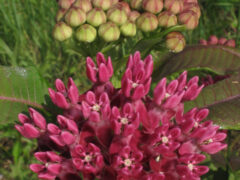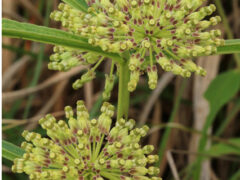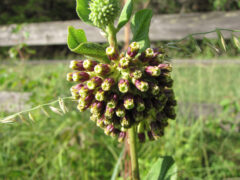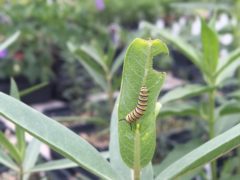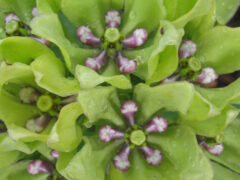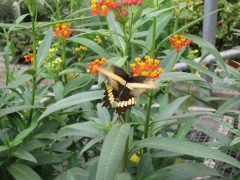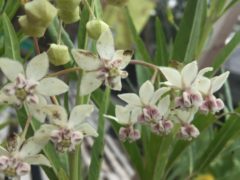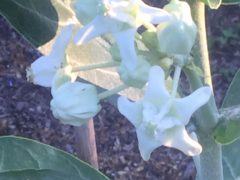Because supporting endangered Monarch butterflies is so important to us we listen to the experts and keep a keen eye on new developments regarding Asclepias curassivica (tropical milkweed) and Monarchs in our area. Although we grow many species of hardy native milkweed, they can be slow to establish and don’t provide much food for hungry caterpillars until they’ve grown for a few years. Some species like Asclepias syriacus (common milkweed) become too tough for young caterpillars to consume by midsummer. Tropical milkweed provides a lot of food fast and is a three-season food source for all stages of Monarch development, from caterpillar to adult. Tropical milkweed makes it possible for those with limited or temporary gardening space a chance to help support Monarchs in addition to offering an instant feeding station for gardeners just getting started on their native habitats.
For these reasons, we continue to believe the benefits of growing tropical milkweed are great. Combined with assurances from experts at Monarch Watch, local butterfly maven Lenora Larson, and analysis from scientists like Dr. Dara Satterfield and Dr. Jeffrey Glassberg, we continue to feel confident that the dangers of growing tropical milkweed are not relevant to our cold climate.
Although there is data to show that tropical milkweed can cause higher than normal levels of parasitic infection in Monarchs feeding on tropical milkweed plants in winter in warm climates of the south and west coast where plants are not killed by freezing weather, experts agree that this is not a danger when tropical milkweed dies in cold climates during winter months.
It is important to note that most native milkweeds (of which there are dozens of species used by monarchs in North America) die back during the fall as monarchs begin their journeys southwards. However, tropical milkweed (an exotic species to most of North America) often grows year-round in warm, coastal areas. Year-round availability of tropical milkweed enables monarchs to breed during the fall and winter months, a behavior that increases O.e. infection risk for those butterflies.
— The link between OE disease and tropical milkweed in coastal monarchs: by Dara Satterfield
Some researchers have also suggested that in addition to exposure to O.e., tropical milkweed might cause Monarch butterflies to lay eggs too late in the season and that the presence of tropical milkweed in winter prevents them from migrating. Our friends at Monarch Watch have assured us that even if this theory is proven to be true, it does not affect Monarchs in our area since we are far enough north that tropical plants are killed by frost.
The buildup of O.e. spores on the plant is the main concern. However, this is only the case in areas of the US where there is no hard freeze during the winter. O.e. spores increase throughout the summer on native milkweeds also. In the fall the natives senesce and the tropical dies, removing the O.e. spore load. Growing tropical milkweed in this region is just like growing any other annual plant.
—Dena Podrebarac, Milkweed Coordinator, Monarch Watch, The University of Kansas
… monarchs and O.e. will cycle because of the spatial and temporal complexity of the environment. That complexity is related to the seasonal and spatial distribution of milkweeds and the presence of other species and weather conditions. There are a large number of parasites and predators that prey on monarch eggs, larvae and pupae such that the percentages reaching the adult stage are estimated to be 1-3%. As these species prey on monarchs, they also eliminate O.e. infected immatures. In some cases, the mortality rate due to these species approaches 100%. By eliminating adult monarchs and therefore reducing the distribution of spores to milkweed leaves and giving time for the O.e. spores that are present to degrade, portions of the larger range become monarch and O.e. free, allowing recovery when these locations are found by females that don’t carry spores. These actions create the complexity and escape in space monarchs need to recover from high levels of infection that reduce the population in other locations.
—Chip Taylor, Monarch Watch, The University of Kansas
In short, to do our best for the Monarchs (not to mention declining populations of insects in general), plant as many native plants as you can. And in our location where hard freeze kills tender annual plants, add tropical milkweed to your garden to provide a fast and bounteous food supply for Monarch moms looking for places to lay eggs. The more locations they have available, the less likely O.e. is to infect large numbers of caterpillars.
Additional information and sources:
Monarchs, milkweeds and O. e.: It’s time for a more holistic approach
Chip Taylor, Monarch Watch, April 19th, 2022
Tropical Milkweed and the injurious effects of well-meaning people
by Dr. Jeffrey Glassberg, Winter 2014
The link between OE disease and tropical milkweed in coastal monarchs
by Dara Satterfield, March 2016
A Response to Tropical Milkweed and the injurious effects of well-meaning people by Jeffrey Glassberg article
by Trecia E. Neal, Sonia Altizer, PhD, April 1, 2018
Monarch Menu
Hardy Native Perennials
butterfly weed, milkweed
Asclepias tuberosa
Perennial Plant Association 2017 Perennial Plant of the Year!
Asclepias tuberosa (butterfly weed) features showy orange (pure native) or yellow (selection 'Hello Yellow') flower heads bloom in early summer and continue for a long period on 24-30" plants. Very tough plants tolerate heat and drought in horrible clay soil. Fantastic planted with native grasses, Rudbeckias and other native flowers. Essential food source for Monarch butterflies.
NATIVE TO ALL BUT THE NORTHWESTERN STATES.
‘Hello Yellow’ butterfly weed
Asclepias tuberosa 'Hello Yellow'
A long-lived, low-maintenance perennial, this yellow flowering selection of our native A. tuberosa was discovered in Colorado and offers months of golden yellow blooms. Following flowering, green seed pods develop which rupture to reveal seeds with long, silvery-white, silky hairs great for dried flower arrangements. Pollinators preferred Asclepias tuberosa ‘Hello Yellow’ selection equally to its native parent, which has orange flowers, according to new, unpublished research out of the University of Delaware.
whorled milkweed
Asclepias verticillata
Whorled milkweed blooms later than other milkweeds with white flowers July thru September. The caterpillars in our greenhouses preferred this species to all others! NATIVE FROM MONTANA TO ARIZONA AND EAST TO THE COAST.
common milkweed
Asclepias syriaca
Common milkweed produces dusty pink flower clusters in mid-summer atop large, glossy leaves that resemble a rubber tree plant. Flowers are followed by large, decorative seed pods. Preferred plant of the Monarch butterfly. Grows 3-5' tall in full sun to partial shade. Drought tolerant. NATIVE FROM MONTANA TO TEXAS AND EAST TO THE COAST.
swamp milkweed
Asclepias incarnata
Swamp milkweed sports lightly fragrant flower clusters from early summer through fall. Plants grow 3-5' tall. Choose the pure native pink or the selection called 'Cinderella'. As the name suggests, this species is tolerant of poorly drained sites. CLICK FOR RANGE MAP
‘Ice Ballet’ white swamp milkweed
Asclepias incarnata 'Ice Ballet'
Clusters of white blooms, from mid-summer to autumn are nectar-rich, attracting butterflies galore. As the flowers fade, they are replaced by intriguing seedpods which can be used in fresh or dried cut flower displays. This nursery selection of the native A. incarnata is a naturally occurring variation in the wild and Monarch caterpillars feast on the foliage.
purple milkweed
Asclepias purpurascens
Native to the Eastern, Southern and Midwestern United States similar to the range of the common milkweed, the flowers of this Monarch butterfly larval host plant are a brilliant magenta. NATIVE TO THE EASTERN HALF OF THE U.S.
tall green milkweed
Asclepias hirtella
Plants grow up to 4′ and produce white flowers. This species prefers medium-wet to dry soil and grows best in full sun to partial shade. Blooms mid-summer and is attractive to butterflies and bees, including honeybees, bumblebees, and leaf-cutting bees. NATIVE FROM KANSAS TO WEST VIRGINIA, MINNESOTA TO LOUISIANA.
poke milkweed
Asclepias exaltata
A shade-loving milkweed actually exists! Found in woodland openings, poke milkweed thrives in dappled to full shade. Plants grow up to five feet and produce large clusters of white to cream florettes tinted with purple and green, flowers on slender stalks. The foliage and flowers provide a source of food for many insects including Monarch butterflies and the larvae of some moths. Long-lived and well-behaved, plants can sometimes hybridize with common milkweed when plants are located in very close proximity. According to Prairie Moon Nursery, "this Milkweed species can show stress the first year and may go into dormancy early; yellow, dropping leaves after transplant can mean there is too much light or the soil is too dry, but the plant can adapt and show progress the next year." Native to the eastern U.S.
green comet milkweed
Asclepias viridiflora
Produces copious amounts of nectar especially adored by bumble bees. Flowers have a sweet odor that attracts all sorts of pollinators, and is another larval host plant of monarch butterfly caterpillars. Often occurs in light shade and where it may be more difficult for monarchs to find, but for gardeners with more shade it offers an excellent option. Green comet tolerates moist to dry roadsides, fields, and prairie and can be found from Montana south through Wyoming, Colorado, Arizona, New Mexico, and east to Florida and New York.
showy milkweed
Asclepias speciosa
Showy milkweed produces dusty pink flower clusters in mid-summer atop large, glossy leaves that resemble a rubber tree plant. Flowers are followed by large, decorative seed pods. NATIVE TO THE WESTERN HALF OF THE U.S.
spider milkweed, green antelopehorn
Asclepias viridis
Attracts monarch butterflies and a host of other insects while being tolerant of heat and dry conditions, with pale pink flowers surrounded by green in showy clusters. A good choice for the butterfly gardener with limited space! NATIVE FROM NEBRASKA TO OHIO, SOUTH TO FLORIDA AND BACK TO TEXAS.
Tropicals (fast & abundant food supply)
‘Silky Gold & Red’ tropical milkweed
Asclepias curassavica
'Silky Deep Red' blooms scarlet red and yellow two-tone. 'Silky Gold' sports yellow blooms. Both provide food for monarch and queen caterpillars and butterflies. These annual butterfly milkweeds are covered with vivid blooms all summer. Collect seed in fall for next spring's garden!
Tropical milkweed is a safe and reliable food source for Monarch butterflies in our area according to Monarch Watch and other experts! Read more on the garden blog:
We're Still Growing Tropical Milkweed. Here's Why ...
balloon plant, hairy balls
Gomphocarpus physocarpa
Native to southeast Africa, this upright shrubby is grown as an annual in Kansas and typically grows to 4-6' tall on stems clad with lanceolate green leaves (to 4" long). This milkweed family member is perhaps best noted for its soft, spherical, balloon-like, spiny, lime-green seed pods. Showy in the garden, great for butterflies and creative floral arrangements. Pods ripen to tan before splitting open in fall to release large numbers of silky-haired seeds to the wind. White drooping flowers are small, with white hoods and about 1/2" across.
giant milkweed
Calotropis gigantea
Thrives in medium moisture and well-drained soils in full sun. Established plants tolerate drought, but best growth and flower production occur in soils with consistent and even moisture. Commonly called crown flower or giant milkweed, this large shrub or small tree is native to India, southern China, Malaysia and Indonesia, but has been extensively cultivated in tropical areas around the world. Flowers appear in clusters and are are commonly used in Hawaii for leis. This giant milkweed is another larval plant for monarch butterflies. Grow as a hedge or small tree in tropical climes. Can be grown in containers and overwintered indoors in our area.
More about gardening for butterflies…
Host plants feed caterpillars. Adults lay eggs on these plants so the newly hatched caterpillars can begin eating right away. As they grow, caterpillars molt and progress to the next instar—1st instar, 2nd instar, 3rd instar, and so forth. Watch for all stages of caterpillar instars and signs of insect feeding on foliage. Holes and jagged-edged leaves are a sign of success in the butterfly garden.
Planting a nectar garden provides food in the form of flowers for adult butterflies, bees, and many other pollinators. Butterfly gardens should always include host and nectar plants to feed lepidopteran species in all life stages.
Vinland Valley Nursery is a registered Monarch Waystation #1085 since February 4, 2007. You can register your garden here!
Local butterfly expert Lenora Larson has created these informational handouts. You can download them here!
• Butterflies: Flying Flowers in your Garden!
• A Vital Connection: Native Plants and Butterflies
• Long Lips Farm Caterpillar Foodplants
• Butterfly Bartending: Nectar Flowers
• Long Lips Farm: Selected Butterfly Nectar Flowers
• Bee Friendly: Plants for Bees and Other Pollinators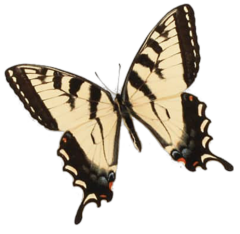
CLICK HERE for photos and information about Monarchs
